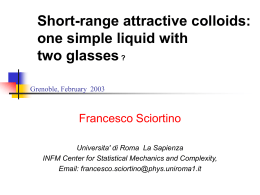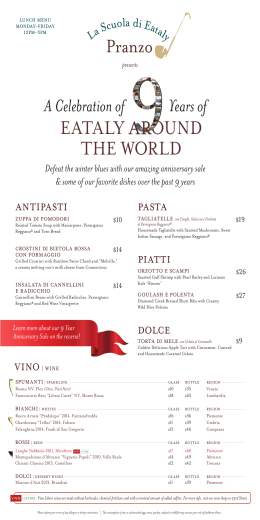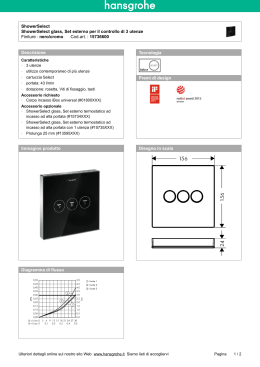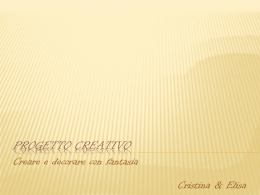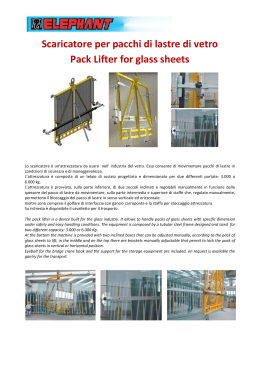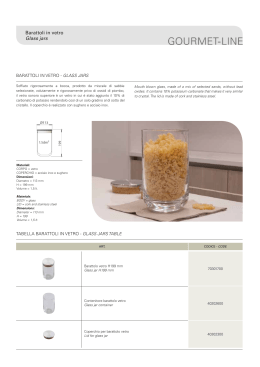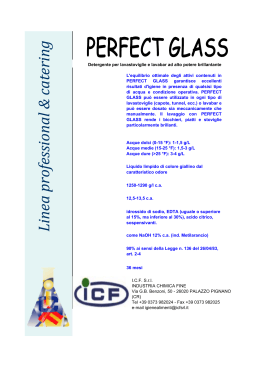PHILIP GLASS : METAMORPHOSIS Floraleda Sacchi PHILIP GLASS : METAMORPHOSIS Floraleda Sacchi (Harp and Creative Mix) 01. Opening (from Glasswork, 1981) Helen's Tune (from The Candyman, 1992) 02. Cue 2a 03. Cue 2b 04. Cue 2c Metamorphosis I-V (1988) 05. I Moderate 06. II Flowing 07. III Moderately Fast 08. IV Flowing 09. V Moderate 10. Modern Love Waltz (1978) 11. Why does someone have to die? (from The Hours, 2002) "Trilogy" Sonata (2000): 12. I Knee Play No. 4 (from Einstein on the Beach, 1976) 13. II Act III (from Satyagraha, 1980) 14. III Dance (from Akhnaten, 1983) 15. Closing (from Glasswork, 1981) Total Time: 64'08' : Since 2007 Floraleda Sacchi performs regularly Philip Glass' works on Harp. She realized Glass' music works perfectly on Harp and since then she became for many years the only harpist regularly performing worldwide his music in concerts, tv and radio broadcasts: performances were listed on official Glass' website and some Glass’ pieces were recorded live in 2010 for the American Harp Society as important contribution to Harp repertoire. Beside live performances, in 2007 Floraleda recorded 'Open the Kingdom' for the CD ‘Suite en Duo’ published by PHILIPS label (Cat. No. 476 5978). In 2008, she included the five 'Metamorphosis' in her celebrated recording 'Minimal Harp' (DECCA, cat. No. 476 3172). Finally, in 2012, she recorded this album for Portraits' Collection by Amadeus Arte with a lot of world premières for the Harp and with a completely new sound approach opening a new dimension for this music. *** "Ms Sacchi invents a fascinating chapter of modern history of the harp." Angelo Foletto, La Repubblica ''I'm pretty sure fans of Glass will be stunned by these renditions.'' Tokafi Magazine ''The way Floraleda performs Philip Glass goes beyond the wonder.'' Tommaso Labranca, Acid Jazz Dal 2007 Floraleda Sacchi esegue regolarmente la musica di Philip Glass con l'arpa. Dopo aver intuito che la musica di Glass suonava al meglio sull'arpa, Flora è diventata per molti anni l’unica arpista ad eseguire regolarmente la sua musica in tutto il mondo in concerti, radio e tv: le esecuzioni sono elencate sul sito ufficiale di Glass e alcuni brani sono stati anche registrati live nel 2010 per l’American Harp Society come importante contributo al repertorio per arpa. Oltre alle esecuzioni dal vivo, nel 2007 Floraleda ha registrato 'Open the Kingdom' nel CD ‘Suite en Duo’ pubblicato da PHILIPS (n. catalogo 476 5978). Nel 2008, ha incluso le cinque 'Metamorphosis' nel suo celebrato CD 'Minimal Harp' (DECCA, n. catalogo 476 3172). Finalmente, nel 2012, ha registrato questo album monografico per la collana Portraits' Collection di Amadeus Arte con molte nuove opere registrate per la prima volta sull’arpa e con un approccio sonoro completamente nuovo che apre una nuova dimensione per questa musica. *** "La Sacchi inventa un nuovo e affascinante capitolo della storia moderna dell’arpa." Angelo Foletto, La Repubblica ''Sono assolutamente certo che i fan di Glass saranno stupefatti da queste esecuzioni.'' Tokafi Magazine ''Il modo in cui Floraleda suona Philip Glass va oltre la meraviglia.'' Tommaso Labranca, Acid Jazz : Opening e Closing (da Glasswork) "Glassworks è stato il mio CD di debutto per la CBS. Questa musica è stata scritta solo per essere incisa, ma alcuni pezzi sono poi entrati nel repertori da concerto dell’Ensemble. Glassworks è un opera in sei movimenti concepita per introdurre la mia musica ad un pubblico più vasto che ancora non la conosceva." Philip Glass Per questa ragione ho aperto questa registrazione con “Opening", il primo movimento di Glasswork, e chiuso il disco con l’ultimo movimento "Closing". I due brani sono identici, ma arrangiati diversamente con il risultato di due diverse sonorità e colore: la differenza tra un inizio e una fine è spesso questione di una sfumatura. Questo trattamento del suono è comune nella musica di Glass e lavorare su quest’aspetto è per me assolutamente entusiasmante. Quindi Opening per pianoforte solo è qui registrato per arpa sola e Closing per archi, fiati e pianoforte ha alcune battute sovraincise e il suono è stato elaborato elettronicamente per ricreare l’arrangiamento di Glass, ma anche per aprire e chiudere una nuova dimensione sonora per l’arpa e per questi brani. Helen's Tune (da The Candyman) Candyman è un horror datato 1992 con colonna sonora di Philip Glass. La regia è di Bernard Rose e la trama è basata sul racconto "The Forbidden" di Clive Barker. La storia racconta di Helen Lyle, una studentessa che decide di scrivere una tesi su miti e leggende metropolitane. In un quartiere della città raccoglie la storia : Opening and Closing (from Glasswork) "Glassworks was my debut record on CBS. This music was written for the recording studio, though a number of the pieces soon found their way into the Ensemble repertory. A six-movement work, Glassworks was intended to introduce my music to a more general audience than had been familiar with it up to then." Philip Glass For this reason I opened this CD with "Opening", the first movement of Glasswork, and closed it with the last one "Closing". The two pieces are even in notes, but arranged with differently with the result of two different sounds/colours: when something starts or ends, often the difference is just a shade. This sound treatment is common in Philips Glass' music and work on this level is the most inspiring thing for me. So Opening, for solo Piano is performed here for solo Harp and Closing for Strings, Winds and Piano, has some parts overdubbed and the sound is electronically elaborated to recreate the original arrangement by Glass and to open and close a new sound dimension for the Harp and these pieces. Helen's Tune (from The Candyman) Candyman is an horror movie dated 1992 with soundtrack by Philip Glass. It was directed by Bernard Rose and is based on the short story "The Forbidden" by Clive Barker. The story tells about Helen Lyle, a student who decides to write a thesis about local legends and myths. She visits a part of the town, where she learns about the legend of the di Candyman, un uomo con un solo braccio che appare quando il suo nome viene ripetuto per cinque volte di fronte ad uno specchio. Ovviamente, Helen non crede a questa storia, ma le persone della zona ne sembrano terribilmente spaventate. Ignorando gli avvertimenti e indagando sulla vicenda incominciano a verificarsi anche una serie di delitti. La leggenda è dunque realtà? La colonna sonora di Candyman inizia con il tema più famoso "Helen's Theme". Con il procedere della storia e il mutare della realtà anche la vita di Helen cambia e parallelamente il colore del tema riproposto per organo, piano e celesta. Ho eseguito il tema con 3 colori diversi e per rispettare l’intenzione del compositore ho lavorato anche in mixaggio. Candyman, a one-armed man who appears when you say his name five times, in front of a mirror. Of course, Helen doesn't believe all the local legend, but the people of the area are really afraid. When she ignores their warnings and begins her investigation in the places that he is rumored to appear, a series of horrible murders begins. Could the legend be true? The Candyman soundtrack begins with its most famous theme, or "Helen's Theme". As the story develops and the reality changes, as well as Helen's life, the theme changes color too, so one can hear it played from Piano, Organ or Celesta. I played the theme 3 times with different colours respecting the composer's intention, but also working with a creative mixing. Metamorphosis I-V Metamorphosis è un brano scritto nel 1988 ed ispirato all’omonimo racconto di Kafka. Le Metamorfosi 3 e 4 sono nate come musica di scena per due diverse compagnie teatrali che commissionarono a Glass simultaneamente della musica sullo stesso racconto. Le Metamorfosi n. 1, 2 e 5 ripropongono temi della colonna sonora composta da Glass per il film di Errol Morris The Thin Blue Line, che racconta la vera storia di un omicidio a Dallas erroneamente attribuito ad un poliziotto. La Metamorfosi 2 è stata usata anche nel film The Hous del 2002 e i cinque brani suonati (anche da Glass) per accompagnare spettacoli di danza. Considerando i 5 brani nel loro insieme, i numeri 1-3 introducono vari elementi che vengono miscelati nel quarto brano per poi ritornare all’origine iniziale nell’ultimo movimento (che è quasi uguale al primo). In tutte le 5 Metamorfosi c’è l’unione di tonalità maggiori e minori e ritmo binario e ternario (2+3 = 5) nel tentativo di Metamorphosis I-V Metamorphosis was written in 1988 and takes its name from Kafka's short story. Metamorphosis three and four are from Glass's incidental music to the play, which he wrote to fulfill separate but nearly simultaneous requests from two different theater companies. Numbers one, two and five use themes from Glass's soundtrack to the Errol Morris film The Thin Blue Line, which depicts the true story of a man's wrongful conviction for the murder of a Dallas police officer. Metamorphosis No. 2 was also used in the film "The Hours" in 2002; however, Metamorphosis have often been played (even by Glass himself) to accompany dance performances… Considering the 5 pieces together, Nos. 1-3 introduce various elements which are mixed together in Metamorphosis No. 4 to come back to their origin in Metamorphosis no. 5 (which is quite the the same as No. 1). In all five Metamorphoses there is a union of major and minor tonalities and binary and ternary rhythm (2 + 3 = 5) : trovare un punto di equilibrio tra gli opposti. Questo sforzo crea il dinamismo e la staticità che coesistono in questi brani. Quando vengono eseguite sull’arpa, le Metamofosi si trasformano in brani di grande resistenza e virtuosismo, integrandosi perfettamente con lo strumento. Metamorphosis è il brano di Glass che ho eseguito maggiormente e che mi ha portato a suonare la sua musica sul mio strumento. in an attempt to find a point of equilibrium between opposites. This attempt creates the dynamism and static quality that coexist in these compositions. When played on the Harp, Metamorphosis become pieces of great strength and virtuosity, integrating with the Harp perfectly. Metamorphosis is the piece by Glass I played more and it's "the piece" that brought me to play his music on Harp. Modern Love Waltz Brano scritto per accompagnare la versione radiofonica del romanzo Modern Love di Constance DeJong, la cui scrittura è strettamente legata alla messa in scena. Modern Love, il suo primo romanzo, fu pubblicato nel 1977 da Standard Press e nel 1978 il testo fu adattato in un programma radiofonico di 60 minuti accompagnato da questa musica. DeJong ha curato anche il libretto per l’opera Satyagraha di Glass. Amo molto questo brano e lo suono un po’ più velocemente del tempo indicato: l’amore moderno può essere un po' più pungente e inquieto. Modern Love Waltz Written for Constance DeJong's performance of her novel Modern Love. DeJong's writing is closely tied to performance practice. Her first book, Modern Love, was published in 1977 by Standard Editions. In 1978, this text was adapted into a 60 minute radio program accompanied by the piece by Glass called "Modern Love Waltz". DeJong created also the libretto for stage work Satyagraha by Glass. I love this piece and like to play it a bit faster than indicated: modern love can be a bit more biting and unquiet. Why does someone have to die? (da The Hours) Musica composta per il film di Stephen Daldry The Hours. The Hours è la storia di tre donne che cercano un'esistenza più ricca e significativa. Basato sul romanzo Premio Pulitzer del 1999 di Michael Cunningham, il film intreccia le storie di tre donne - un editore a New York (Meryl Streep), una giovane madre in California (Julianne Moore) e la scrittrice Virginia Woolf (Nicole Kidman). Le loro storie s'intrecciano e, alla fine, si fondono in un sorprendente, momento trascendente di riconoscimento condiviso. In questo pezzo ho lavorato elaborando il suono dell'arpa per creare l'effetto degli archi, che si muovono : Why does someone have to die? (from The Hours) Music for the film by Stephen Daldry The Hours. The Hours is the story of three women searching for more potent, meaningful lives. Based on Michael Cunningham's 1999 Pulitzer Prize winning novel, the film interweaves the stories of three women - a book editor in New York (Meryl Streep), a young mother in California (Julianne Moore) and author Virginia Woolf (Nicole Kidman). Their stories intertwine, and finally come together in a surprising, transcendent moment of shared recognition. In this piece I worked elaborating the sound of the Harp to create the effect of strings, working restlessly in a lower costantemente nel registro grave, e del pianoforte che aggiunge scintille e raggi di luce su questo sfondo scuro. register, and piano adding sparkles and rays of light on a dark background. "Trilogy" Sonata La Sonata consiste nell'arrangiamento per pianoforte di scene prese dalla trilogia di opere "ritratto" di Philip Glass: Einstein on the Beach (1976), Satyagraha (1980), e Akhnaten (1983). Queste tre opere sono state descritte da Glass come ritratti di uomini che con la forza delle loro idee trasformarono il loro tempo anziché usare le armi. La loro visione interiore agì su diversi aspetti: Akhenaten tramite la religione, Einstein con la scienza e Gandhi con la politica. Einstein on the Beach è un'opera in 4 atti (incorniciati e connessi da cinque "knee plays" o intermezzi), composta da Philip Glass e diretta dal produttore teatrale Robert Wilson. L'opera non ha trama, ogni quadro riguarda un aspetto delle ricerche di Einstein e i Knee Plays sono momenti musicali che permettono anche il cambio di scena. Satyagraha (una parola in sancrito che significa "truth force") è un'opera liberamente basata sulla vita di Gandhi. Il libretto di Constance DeJong si basa su testi del Bhagavadgita cantati in lingua originale. Akhnaten è un'opera in tre atti che narra la vita e le convinzioni religiose del faraone Akhenaten (Amenofi IV). La scena inclusa nella sonata descrive la costruzione della città santa e la danza felice che celebra la trsformazione di un luogo immaginato in realtà. "Trilogy" Sonata The Sonata consists of piano arrangement of scenes from the trilogy of "portrait" operas by Philip Glass: Einstein on the Beach (1976), Satyagraha (1980), and Akhnaten (1983). These three operas were described by Glass as portraits of men that through the power of ideas transformed the thinking of their times rather than using military force. The inner vision of these three people acted at different levels: Akhenaten in religion, Einstein in science and Gandhi in politics. Einstein on the Beach is an opera in four acts (framed and connected by five "knee plays" or intermezzos), scored by Philip Glass and directed by theatrical producer Robert Wilson. The opera has not a plot: each scene depict an aspect of Einstein research and Knee Plays are musical moments that permit to change the scene. Satyagraha (a Sanskrit word meaning "truth force") is an opera loosely based on the life of Gandhi. The libretto by Constance DeJong is based on Bhagavadgita and the texts are used in the original language. Akhnaten is an opera in three acts based on the life and religious convictions of the pharaoh Akhenaten (Amenhotep IV). The passage included in the sonata depict the building of the holy city and the happy dance celebrating the transposition of an ideal place into reality. Floraleda Sacchi : Floraleda Sacchi : Described as an 'artist of exceptional talent', Floraleda has always dedicated herself to the harp solo and chamber music repertoire trying to develop original projects and a personal way of making music. She has performed as soloist all over the world in major halls and festivals such as: Carnegie Hall-Weill Recital Hall (New York), United Nations Palace (New York), Klang-Bogen (Vienna), Gewandhaus (Leipzig), Konzerthaus (Berlin), Sala Verdi (Milan), Teatro Valle (Rome), Matsuo Hall (Tokyo), Prefectural Hall Alti (Kyoto), Salle Varèse (Lyon), Gasteig (Munich), HypoKunsthalle (Munich), Concerts de la Croix Rouge (Geneva), Theatre Bellevue (Amsterdam), Gessler Hall (Vancouver), CBC Glenn Gould Studio (Toronto), Teatro Bibiena (Mantova), etc. revealing herself as one of the most interesting and original harpists on the international concert panorama. She is the only harpist recording for DECCA, Philips, Universal Music and Deutsche Grammophon, but beside the 'majors' she recorded many other CDs with original music for Harp. In 2011 she created Portraits' Collection for Amadeus Arte label: each CD is dedicated to a composer whith a tight relationship to Flora. Floraleda Sacchi, born in Como, initially dedicated herself to dance. Inspired to play the harp by Annie Challan recordings, she started studying with Lisetta Rossi when she was 14. She later studied with Alice Giles (Frankfurt a/M), Alice Chalifoux (Salzedo School, Camden, ME, USA) and with Judy Loman (Toronto, Canada). "Sacchi delivers the best harp playing I've ever heard." Gil French, American Records Guide www.floraledasacchi.com Descritta come artista di 'eccezionale talento', Floraleda si è sempre dedicata al repertorio solistico e cameristico cercando di sviluppare progetti originali e una via personale per fare musica. Ha suonato come solista in tutto il mondo nelle principali sale da concerto e festival quali: Carnegie Hall-Weill Recital Hall (New York), United Nations Palace (New York), Klang-Bogen (Vienna), Gewandhaus (Leipzig), Konzerthaus (Berlino), Sala Verdi (Milano), Teatro Valle (Roma), Matsuo Hall (Tokyo), Prefectural Hall Alti (Kyoto), Salle Varèse (Lione), Gasteig (Monaco), Hypo-Kunsthalle (Munich), Concerts de la Croix Rouge (Ginevra), Theatre Bellevue (Amsterdam), Gessler Hall (Vancouver), CBC Glenn Gould Studio (Toronto), Teatro Bibiena (Mantova), etc. confermandosi come una delle più interessanti e originali arpiste sulla scena internazionale. E' l'unica arpista ad aver registrato per DECCA, Philips, Universal Music e Deutsche Grammophon, ma accanto alle 'majors' ha registrato molti altri CD con musica originale per arpa. Nel 2011 ha creato la "Portraits' Collection" per l'etichetta Amadeus Arte: ogni CD è dedicato a un compositore che ha una stretta relazione con Flora o con cui ha collaborato direttamente. Floraleda Sacchi, nata a Como, si è dedicata inizialmente alla danza. Ispirata a suonare l'arpa dai dischi di Annie Challan, ha iniziato a studiare con Lisetta Rossi a 14 anni, perfezionandosi successivamente con Alice Giles (Frankfurt a/M), Alice Chalifoux (Salzedo School, Camden, ME, USA) e Judy Loman (Toronto, Canada). "La Sacchi ci regala la miglio esecuzione d'arpa che si sia mai sentita." Gil French, American Records Guide www.floraledasacchi.com : CREDITS PORTRAITS’ COLLECTION Recorded on October 27 and 28, 2012 and mixed on October 29, 2012 in Como (Italy) by Filadelfo Castro and Francesco Ambrosini. EVOCACIONES: Music by Claudia Montero Cat. No. AAP11001 EAN: 9788895450322 Tracks 11 and 15 were overdubbed and creatively mixed. Floraleda plays a Lyon&Healy Harp, Style 30, No. 16516 Cover Photo: Studio Corbetta Produced by Amadeus Arte © 2012 Amadeus Arte Cat. No. AA12002 www.amadeusarte.com For more info on performances, reviews and audio visit: www.floraledasacchi.com (pdp) SPECIFICATIONS: Music by David Clark Little Cat. No. AAP11002 EAN: 9788895450025 INSIDE THE TREE: Music by Peter Machajdik Cat. No. AAP11003 EAN: 9788895450339 IMAGES: Music by Daniele Garella Cat. No. AAP11005 EAN: 9788895450032 HAPPY BIRTHDAY JOHN: Music by John Cage Cat. No. AAP12001 EAN: 9788895450056 METAMORPHOSIS: Music by Philip Glass Cat. No. AAP12002 EAN: 9788895450117 www.portraitscollection.com
Scarica

